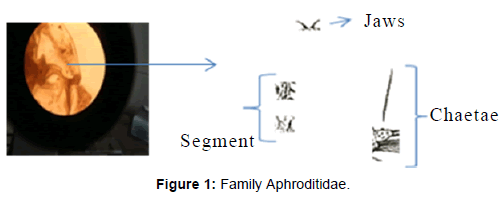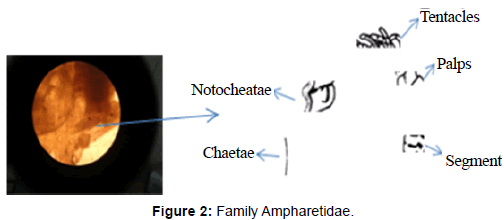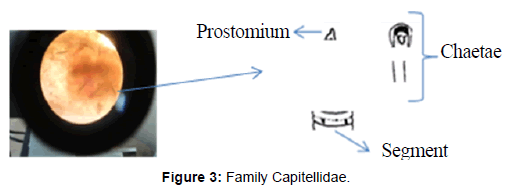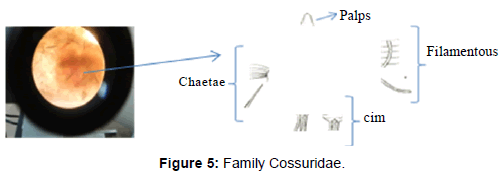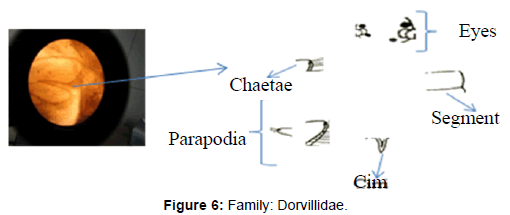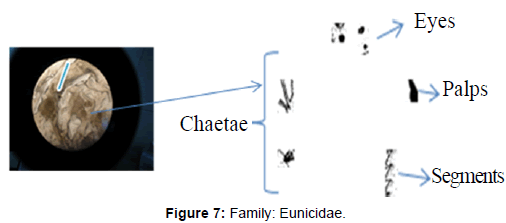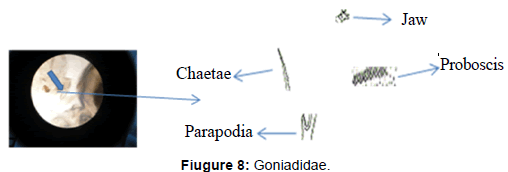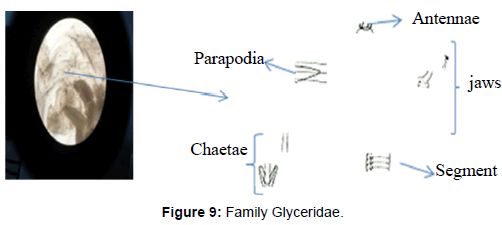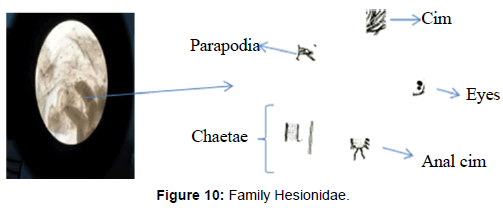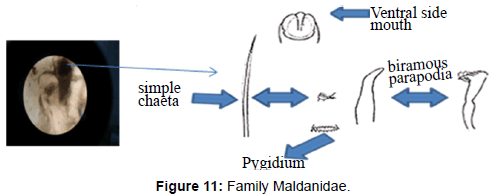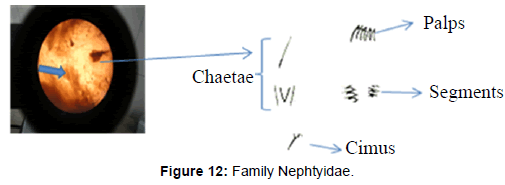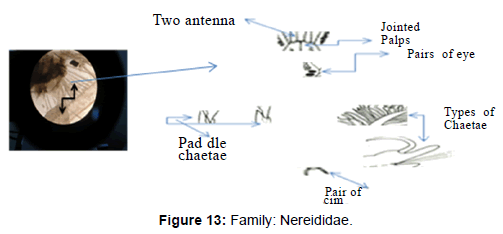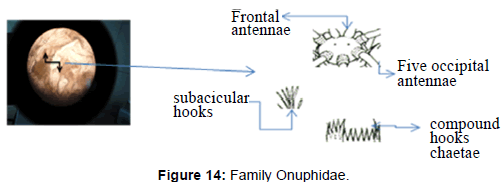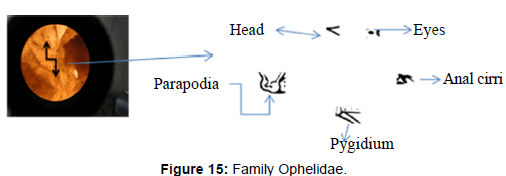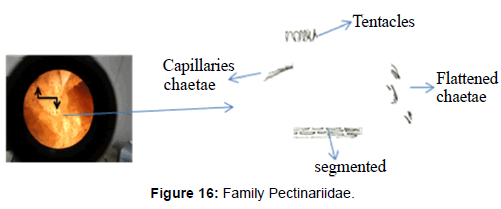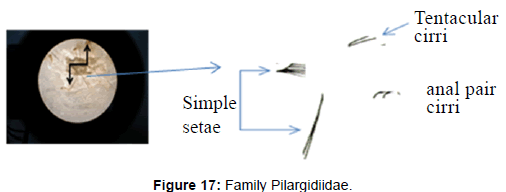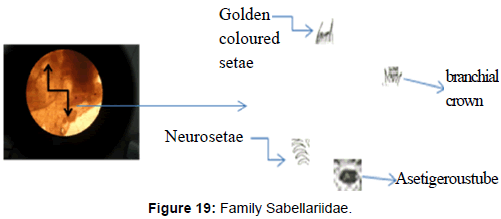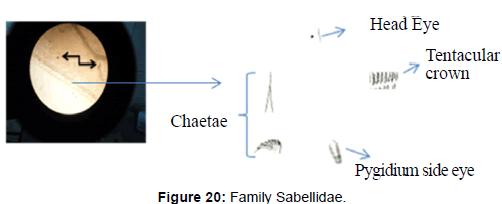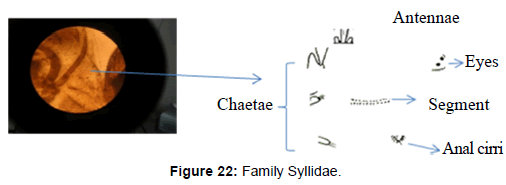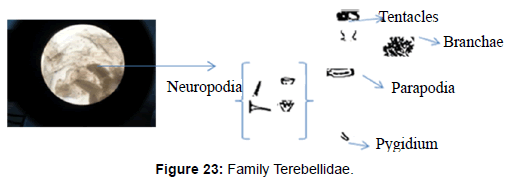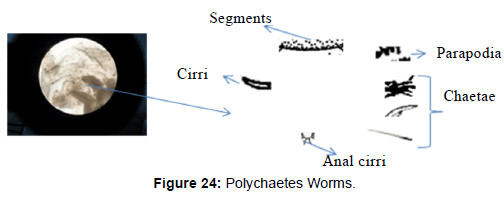Research Article Open Access
Contribution of Polychaetes in Feeding Capability of Commercially Important Crabs, South East Coast of India
D Varadharajan* and P SoundarapandianFaculty of Marine Sciences, Centre of Advanced Study in Marine Biology, Annamalai University, Tamil Nadu, India
- *Corresponding Author:
- D Varadharajan
Faculty of Marine Sciences
Centre of Advanced Study in Marine Biology
Annamalai University, Parangipettai-608 502, Tamil Nadu, India
Tel: 04144-243223
Fax: 04144-243553
E-mail: heartvaradhan@gmail.com
Received date February 27, 2013; Accepted date May 13, 2013; Published date May 18, 2013
Citation: Varadharajan D, Soundarapandian P (2013) Contribution of Polychaetes in Feeding Capability of Commercially Important Crabs, South East Coast of India. J Marine Sci Res Dev 3:123. doi: 10.4172/2155-9910.1000123
Copyright: © 2013 Varadharajan D, et al. This is an open-access article distributed under the terms of the Creative Commons Attribution License, which permits unrestricted use, distribution, and reproduction in any medium, provided the original author and source are credited.
Visit for more related articles at Journal of Marine Science: Research & Development
Abstract
The food is very important for growth, metabolism, parasitic, migratory movement, maturity, reproduction, breeding and survival of all life stages. A commercially important crab has a great demand in the market because of its high nutritional value and medicinal use. The study of food and feeding habits of crab has a variety of importance in fishery biology. For well grow farming a thorough knowledge about the food and feeding habit is important. The studies of interactions between the links in complex food chains can lead to an understanding of crab gain their food sources. The examination of gut contents of crab provides information about particular crab in the ecosystem.
Keywords
Food; Growth; Survival; Farming; Commercial crabs
Introduction
Portunidae of the swimming crabs are common in tropical and subtropical estuarine and near shore habitats. Crabs are filter feeders, detritus feeders, plant and carrion feeders, scavengers and predators and many of them use more than one method of feeding and various sources of food [1]. The polychaete from a number of habitats both intertidal, subtidal and the plant substrata of mangrove, seagrass and seaweed provide feed, spawning and nursery grounds for many organisms and a vast range of direct and indirect products and benefit their role in the energy flow and the diet of crabs [2-5]. The number of species of marine crabs is edible, the large ones and highly esteemed species suitable for coastal aquaculture. The crab farmers as well require knowing how much feed their farm animals have actually consumed but this can be difficult to judge. On the basis of the nature of the food taken, this is often overlapping different feeding categories in decapods. The knowledge of the food and feeding of crab is very important ones since to start hatchery or farming. The distribution of marine benthos varies both temporally and spatially due to the roughness of their occurrence [5,6]. The main difficulty when studying the diet of crab is the identification of gut contents to a specific level. So far the regarding of polychaetes the presence of certain structures which are more resistant to digestion, such as setae, uncini, hooks, mouthpieces and opercula, allows the determination to family level. In the present study, gut contents of commercially important crabs were analysing, there are contain a number of carnovore particle, however, specically were identified the main feed of crabs in annelids polychaetes particle. Since, the study was indicating the loss of species diversity, due to effects of predation.
Materials and Methods
The study was conducted from Sethubavachatram it is situated along the Palk Strait in the southeast part of India. Seasonal sampling at different depths 0-5, 5-10, 10-15 and 15-30 m was carried out by means of an otter trawl in collecting crab species in different marine sites. For this study, 12 species of commercial brachyuran crabs were selected. After collection, the crabs were stored in ice boxes and the gut contents were removed and fixed 10% buffered formalin. The gut contents were later analyzed in the laboratory the presumed polychaete material was sorted and preserved in 70% alcohol for further identification, based on the presence of structures as body segment of antennae, prostomium, peristomium, parapodium, setae, uncini, hooks, mouthpieces and opercula. An attempt was made to identify Polychaeta in the gut contents to species level by investigating the fragments with a microscope. However, this method tends to overestimate substance with hard parts and small substance such as annelids polychates which contribute little to the relative volume of the gut contents [7]. The identified preys of polychaetes were using standard references.
Results
Commercial crab gut contents identified different family Polychaetes in different structures
The Aphroditidae family species parts were identified in different crab guts in the following order; S. serrata>P. pelagicus>S. tranquebarica>C. feriata>C. lucifera>C. variegata>C. granulata>P. sanguinolentus>C. gladiator>P. vigil>C. natator>C.truncata (Figure 1). The Ampharetidae family species parts were identified in different crab guts in the following order; S. serrata>P. pelagicus>C. gladiator>C. granulata>S. tranquebarica>C. natator>C. variegata>P. sanguinolentus>P. vigil>C. lucifera>C. feriata>C. truncata (Figure 2). The Capitellidae family species parts were identified in different crab guts in the following order; S. serrata>P. vigil>S. tranquebarica>P. sanguinolentus>C. granulata>P. pelagicus>C.truncata>C. natator>C. variegata>P. gladiator>C. feriata>C. lucifera (Figure 3). The Cirratulidae family species parts were identified in different crab guts in the following order; S. serrata>C. natator>S. tranquebarica>P. sanguinolentus>P. gladiator>C. lucifera>C. granulata>P. pelagicus>P. vigil>C. feriata>C. truncata>C. variegata (Figure 4). The Cossuridae family species segments were identified in different crab guts in the following order; S. serrata>C. feriata>S. tranquebarica>P. gladiator>P. vigil>C. lucifera>C. granulata>C. truncata>P. pelagicus>P. sanguinolentus>C. natator>C. variegata (Figure 5). The Dorvillidae family species parts were identified in different crab guts in the following order; S. serrata>S. tranquebarica>P. pelagicus>P. sanguinolentus>P. vigil>C. natator>C. variegata>C. gladiator>C. granulata>C.truncata>C. feriata> C. lucifera (Figure 6). The Eunicidae family species segments were identified in different crab guts in the following order; S. tranquebarica>S. serrata>P. sanguinolentus>C. gladiator>P. pelagicus>P. vigil>C. feriata>C. natator>C.variegata>C. granulata>C. lucifera>C.truncata (Figure 7).
The Goniadidae family species parts were identified in different crab guts in the following order; S. serrata>S. tranquebarica>P. pelagicus>P. sanguinolentus>P. gladiator>C. natator>C. granulata>C. variegata>C.truncata>P. vigil>C. lucifera>C. feriata (Figure 8). The Glyceridae family species parts were identified in different crab guts in the following order; S. serrata>S. tranquebarica>P. pelagicus>P. sanguinolentus>C. gladiator>C. feriata>C. variegata>C. truncata>P. vigil>C. lucifera>C. natator>C. granulata (Figure 9). The Hesionidae family species segments were identified in different crab guts in the following order; S. serrata>S. tranquebarica>P. vigil>P. gladiator>C. natator>C. granulata>P. pelagicus>C. lucifera>P. sanguinolentus>C. variegata>C. feriata>C. truncata (Figure 10). The Maldanidae family species parts were identified in different crab guts in the following order; P. vigil>C. granulata>S. tranquebarica>P. pelagicus>C. lucifera>S. serrata>P. sanguinolentus>P. gladiator>C. feriata>C. natator>C. variegata>C. truncata (Figure 11). The Nephtyidae family species segments were identified in different crab guts in the following order; S. serrata>S. tranquebarica>P. sanguinolentus>C. feriata>C. natator>C. variegata>C. granulata>P. pelagicus>P. gladiator>C. truncata>C. lucifera>P. vigil (Figure 12). The Nereididae family species parts were identified in different crab guts in the following order; S. serrata>S.tranquebarica>P. pelagicus>P. sanguinolentus>C. variegata>P. gladiator>P. vigil>C. natator>C. lucifera>C. granulate>C. feriata>C. truncata (Figure 13). The Onuphidae family species segments were identified in different crab guts in the following order; S. serrata>C. gladiator>C. granulata>P. pelagicus>P. sanguinolentus>S. tranquebarica>P. vigil>C. feriata>C. natator>C. lucifera>C. truncata>C. variegata (Figure 14). The Ophelidae family species parts were identified in different crab guts in the following order; S. serrata>S. tranquebarica>P. pelagicus>C. lucifera>P. sanguinolentus>P. vigil>C. feriata>C. granulata>C. natator>C. gladiator>C. variegata>C. truncata (Figure 15).
The Pectinariidae family species segments were identified in different crab guts in the following order; S. serrata>P. sanguinolentus>C. feriata>C. truncata>S. tranquebarica>P. vigil>C. natator>C. lucifera>C. variegata>C. granulata>P. pelagicus>C. gladiator (Figure 16). The Pilargidiidae family species segments were identified in different crab guts in the following order; S. serrata>P. pelagicus>C. gladiator>P. vigil>C. feriata>C. granulate>C. lucifera>C. natator>S. tranquebarica>C. variegata>C. truncata>P. sanguinolentus (Figure 17). The Pisionidae family species parts were identified in different crab guts following order; S. tranquebarica>S. serrata>P. gladiator>P. sanguinolentus>C. natator>C. granulata>P. vigil>C. feriata>C. lucifera>P. pelagicus>C. variegata>C. truncata (Figure 18). The Sabellariidae family characters were identified in crab guts from; S. serrata>S. tranquebarica>P. sanguinolentus>C. feriata>P pelagicus>C. lucifera>C. variegata>C. truncata>P. gladiator>P. vigil>C. granulate>C. natator (Figure 19). The Sabellidae family characters were identified in crab guts from; S. serrata> S. tranquebarica>C. lucifera>C. natator>P. gladiator>P. vigil>P. pelagicus> P. sanguinolentus>C. granulate>C. truncata>C. variegata>C. feriata (Figure 20). The Spionida family characters were identified in crab guts from; S. serrata>P. gladiator>P. pelagicus>C. feriata>C. variegata>S. tranquebarica>P. sanguinolentus>C. lucifera>C. natator>C. granulata>P. vigil>C. truncata (Figure 21). The Syllidae family characters were identified in crab guts from; S. serrata>P. vigil>C.variegata>P. sanguinolentus>C. natator>C. granulata>S. tranquebarica>P. pelagicus>C. lucifera>C. truncata>P. gladiator>C. feriata (Figure 22). The Terebellidae family characters were identified in crab guts from; S. serrata>S. tranquebarica>P. vigil>C. feriata>P. sanguinolentus>P. gladiator>P. pelagicus>C. lucifera>C. truncata>C. natator>C. variegata> C. granulate (Figure 23). Unidentified worms: The polychaetes worms characters were identified in crab guts from; S. serrata>P. pelagicus>C. feriata>P. gladiator>P. sanguinolentus>P. vigil>C. natator>S. tranquebarica>C. variegata>C. granulata>C. truncata>C. lucifera (Figure 24).
Discussion
In the present study were examined twelve commercial crabs were collected at a sampling station in different depths and then all crab gut contents analyzed the annelids polychaetes different structure their presence. Most upon the polychaete species under the families like Nereidae, Nephtheidae, Onuphidae, Glyceridae, Spionidae Cirratulidae, Capitellidae, Dorvilleidae, Eunicidae, Spionidae, Maldanidae, Sabellariidae and Syllidae are the major biomass producers among annelids and these form an important food for different species of crabs. The diet variations indicated in the present study are also supported by the observations of that the length of the alimentary canal is indicative of the food preferences of the crabs with carnivores having the largest gut length and detritivores the smallest present the reason of the diversity of annelid polychaetes suitable substratum probably occurs [5,6,8,9]. Differences in the relative length of the alimentary tract of sub adult and adult crabs and attributed it to differences in their feeding habits. This observation is supported by the fact that larger crabs have the capability to digest even low quality food and therefore often meet their energy demands by consuming annelid polychaetes. It is reported that crab metabolism an influence on feeding behavior and feed intake by brachyuran crabs is such that it meets their energy requirements [10]. Thus if a diet has a low energy value, crab will compensate by eating more within the limits of its gut contents capacity [11]. For example S. tranquebarica and S. serrata have reported with comparatively higher fecundity [12]. The portunid crabs breeding activity mostly throughout the year probable, this term agrees with previous studies [13-15]. The changes in the seasons of berried crab availability in the coasts might be due to different monsoonal periods, current patterns and environmental parameters [16,17]. In the present investigations the peak breeding seasons also depend on the available feed and also the surrounding water conditions.
A large proportion of the crab had empty gut contents shortly after high tide. Since the polychaetes are commonly a major component of crab feeds. Such complex pathways of energy flow intensely affect web dynamics, spreading the effects of consumption and efficiency throughout the web [18]. The different food items indicated seasonal variations in diet composition with polychaetes than ranked first followed by plankton during the premonsoon season. The crab gut contents mostly polychaetes and digested matter dominated during the monsoon and post monsoon period. The summer season presents in the crabs gut contents there polychaetes and mud and plant materials. This observation agrees with results, previously reported by Menon and Patel et al. [19,20]. The many crabs are opportunistic feeders eating what is available within a more otherwise less restricted range of items and changes in number of prey types reflect only this plasticity as well as the variability of prey in the particular biotope where the crab is feeding [21,22]. The observations are supported by several reports which indicate polychaetes parts is not easily digest in crab gut contents reason of the segregation of digest enzymes is low. Other food particles the digestion of detritus can supply the consumer with energy and therefore detrital aggregates which are not a normally acceptable food resource may serve as a short term food resource if the consumer can tolerate a temporary nutritional deficiency [16,20,21]. The rapid increase in the feeding intensity in the berrieds and progressively thereafter was coinciding with the length at which maturation is initiated and spawning activities predominate in this species [13,14,17,23]. Typically, when crabs approach maturity they are found to increase the energy devoted to gonad development by increased feeding intensity which supports the observations in this study [24]. Although the strength of feeding in brachyuran crab has been reported to vary with maturity and spawning conditions, being minimal during spawning, high in the maturing group and maximum during post spawning period no such decline in feeding activity of sub adult, adult and berried crabs was observed in the present study [25]. This study agrees with the results previously observed by Rosas et al. [26]. The observation that egg production in many crabs depends more on the energy intake during the spawning season than on the energy reserves accumulated earlier and increased feeding during maturation which enables development of gonadal growth without slowing of somatic growth [27,28]. The situation for the crabs is worse because the temporary habitats occupied by these species are difficult to sample quantities [29]. Even if reliable estimates of abundance were available, estimating the strength of links would still be problematic because determining exactly how many prey predators consume is a difficult task, to the extent that such information is rarely available [30]. The lack of oxygen in bottom waters changes the different types of organisms that exist on the bottom. It is living species change from long living, deep burrowing and slow growing animals to species that live on the sediment surface. They are little and fast growing and can tolerate low concentrations of oxygen otherwise can be difficult to grow. Since, the predators can solve for this kind of problems such as food and feeding activities. The crabs are remarkably adaptable crustaceans that will feed on a wide variety of foods, although some foods are favored over others and individual crabs may have individual preferences. A particular diet may be chosen to seek weight loss or weight gain. In the present investigations clearly indicate that's the crabs prey mostly bottom living organisms it's highly like in annelids polychates. It can play an important role in the regeneration and recycling of nutrients, as their appearance and vital source of food item for the crabs. The culturing time mostly the feeding problems arise due to overfeeding, if given excess food also means more waste. The more food will putrefy and degrade the water quality. In the present study indicates that the interactions between the links in complex food chains can lead to an understanding of how specific organisms gain their food sources. To advance the knowledge of the feeding preferences of brachyuran crabs an understanding of the broader aquatic community is a requisite. However, the scientific knowledge on the crab's food and feeding habits is limited. Hence, this information provides baseline information that's useful for sustainable exploitation and management of fisheries activities.
References
- Sastry AN (1983) Ecological aspects of reproduction, p179-270. In: W.B. Vernberg (Ed.). The Biology of Crustacea: Environment adaptations. New York, Academic Press 8:383.
- Pearson TH, Rosenberg R (1978) Macrobenthic succession in relation to organic enrichment and pollution of the marine environment. Oceanogr Mar Biol Ann Rev 16: 229-311.
- Schembri PJ (1981) Feeding in Ebalia tuberosa (Pennant) (Crustacea: Decapoda: Leucosiidae). J Exper Mar Biol Ecol 55: 1-10.
- Hall SJ, Raffaelli D, Turrell WR (1990) Predator-caging experiments in marine systems: A reexamination of their value. Am Nat 136: 657-672.
- Ansari ZA, Ingole B, Baneerjee S, Parulekar AH (1986) Spatial and temporal changes in benthic macrofauna from Mandovi and Zuari estuaries of Goa, west coast of India. Indian J Mar Sci 15: 223-229.
- Varadharajan D, Soundarapandian P, Gunalan B, Babu R (2010) Seasonal Abundance of Macro Benthic Composition and Diversity along the South East Coast of India. European J Appl Sci 2: 1-5.
- Williams MJ (1981) Methods for analysis of natural diet in portunid crabs (Crustacea; Decapoda: Portunidae). J Exp Mar Biol Ecol 52: 103-111.
- Hill BJ (1976) Natural food, foregut clearance-rate and activity of the crab Scylla serrata. Mar Biol 34: 109-116.
- Haefner, PA Jr (1990) Natural diet of Callinectes ornatus (Brachyura : Portunidae) in Bermuda. J Crust Biol 10: 236-246.
- Stehlik LL (1993) Diets of the brachyuran crabs Cancer irroratus, C. borealis and Ovalipes ocellatus in the New York Bight. J Crust Biol 13: 723-735.
- Williams MJ (1982) Natural food and feeding in the commercial sand crab Portunus pelagjcus Linnaeus, 1766 (Crustacea: Decapoda: Portunidae) in Moreton Bay, Queensland. J Exp Mar Biol Ecol 59: 165-176.
- Pillai KK, Nair NB (1971) The annual reproductive cycles of Uca annulipes, Portunus pelagicus and Metapenaeus affinis (Decapoda: Crustacea) from the South-west coast of India. Mar Biol 11: 152-166.
- Chhapgar BF (1956) On the breeding habits and larval stages of some crabs. Rec Indian Mus 54: 33-52.
- Knudsen lW (1964) Observations on the reproductive cycles and ecology of the common Brachyura and crab-like Anomura of the Puget South, Washington. Pac Science 18: 3-33.
- Ryan EP (1967) Structure and function of the reproductive system of the crab Portunus sanguinolentus (Herbst) (Brachyura : Portunidae). II. Female system. Proc Symp Crust Mar Biol Ass India 522-544.
- Prasad RR, Tampi PRS (1953) A contribution to the biology of the blue swimming crab, Neptunus pelagicus (Linnaeus), with a note on the zoea of Thalamita crenata Latrelle. J Bombay Nat Hist Soc 51: 674-689.
- Varadharajan, D, Soundarapandian P, Dinakaran GK, Vijakumar G (2009) Crab Fishery Resources from Arukkattuthurai to Aiyammpattinam, South East Coast of India. Curr Res J Biol Sci 1:118-122.
- Polis GA, Strong DR (1996) Food web complexity and community dynamics. Am Nat 147: 813-846.
- Menon MK (1952) A Note on the Bionomics and Fishery of the Swimming Crab Neptunus sanguinolenlus (Herbst) on the Malabar Coast. J Zool Soc India 4: 177-184.
- Patel NM, Chhaya ND, Bhaskaran (1979) Stomach contents of Portunus pelagicus (Linn.) from AD net catches. Indian J Mar Sci 8: 48-49.
- Hill BJ (1980) Effect of temperature on the feeding activity in the mud crab Scylla serrata. Mar Biol 59: 189-192.
- Sumpton WD, Smith GS (1990) Effect of temperature on the emergence activity and feeding of male and female sand crabs (Portunus pelagicus). Australian J Mar Freshwater Res 41: 545-550.
- Hines AH (1982) Allometric constraints and variables of reproductive effort in brachyuran crabs. Mar Biol 69: 309-320.
- Hartnoll R (1978) The determination of relative growth in crustacea. Crust 34: 281-293.
- Pillai KK, Nair NB (1968) Observations on the reproductive cycles of some crabs from south-west coast of India. J Mar Biol Ass India 10: 384-385
- Rosas C, Lazaro-Chavez E, Buckle-Ramirez F (1994) Feeding habits and food niche segregation of Callinectes sapidus, C. rathbunae and C. similis in a sub-tropicalcoastallagoon of the Gulf of Mexico. J Crust Biol 14: 371-382.
- Wieczorek SK, Hooper RG (1995) Relationship between diet and food availability in the snow crab Chinoecetes opilio in Bonne Bay, Newfoundland. J Crus Biol 15: 236:247.
- Wassenberg TJ, Hill BJ (1987) Feeding by the sand crab Portunus pelagicus on material discarded from prawn trawlers in Moreton Bay, Australia. Mar Biol 95: 387-393.
- Sheaves MJ, Baker R, Johnston RW (2006) Marine nurseries and effective juvenile habitats: an alternative view. Mar Ecol Prog Ser 318: 303- 306.
- Hall SJ, Raffaelli DG (1993) Food webs: theory and reality. Adv Ecol Res 24: 187-239.
Relevant Topics
- Algal Blooms
- Blue Carbon Sequestration
- Brackish Water
- Catfish
- Coral Bleaching
- Coral Reefs
- Deep Sea Fish
- Deep Sea Mining
- Ichthyoplankton
- Mangrove Ecosystem
- Marine Engineering
- Marine Fisheries
- Marine Mammal Research
- Marine Microbiome Analysis
- Marine Pollution
- Marine Reptiles
- Marine Science
- Ocean Currents
- Photoendosymbiosis
- Reef Biology
- Sea Food
- Sea Grass
- Sea Transportation
- Seaweed
Recommended Journals
Article Tools
Article Usage
- Total views: 15887
- [From(publication date):
September-2013 - Dec 20, 2025] - Breakdown by view type
- HTML page views : 10963
- PDF downloads : 4924

